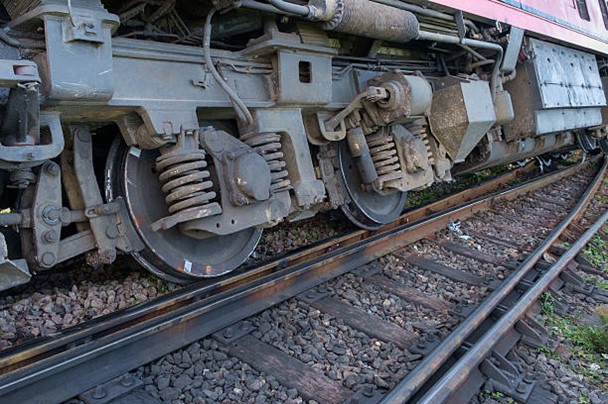
Train derailments can be catastrophic, causing severe injuries, loss of life, and extensive property damage. While train travel is generally safe, derailments still occur due to a variety of factors, from mechanical failures to human error. Understanding the most common causes of train derailments can help prevent future accidents and ensure accountability when negligence plays a role.
What Causes Train Derailments?
A train derailment happens when a train comes off its tracks, often leading to crashes, fires, and hazardous material spills. The Federal Railroad Administration (FRA) reports that derailments are responsible for millions of dollars in damages each year.
The Top Causes of Train Derailments
- Track Defects – One of the leading causes of derailments, broken rails, misaligned tracks, and switch failures can cause trains to jump off their tracks. Poor maintenance increases these risks.
- Mechanical Failures – Malfunctioning brakes, wheel defects, or issues with the locomotive engine can contribute to derailments. Routine inspections are critical to preventing mechanical breakdowns.
- Human Error – Train operators must follow strict speed limits, braking procedures, and track-switching protocols. Mistakes in operation or miscommunication between conductors and rail controllers can lead to derailments.
- Speeding – Excessive speed, especially around curves or in areas with poor track conditions, increases the likelihood of derailments. Many past derailments have been linked to trains traveling above recommended speeds.
- Obstructions on the Tracks – Fallen trees, vehicles at crossings, debris, and even animals on the tracks can force a train off its rails. Railroad companies must ensure tracks are clear and visible.
- Defective Train Components – Faulty couplings, axles, or wheel bearings can cause trains to separate or become unstable, leading to derailments. Manufacturing defects can also play a role.
- Poor Weather Conditions – Heavy rain, flooding, snow, and ice can weaken tracks, cause landslides, or reduce a train’s ability to brake effectively.
- Hazardous Cargo & Overloading – Trains carrying hazardous materials must follow strict safety regulations. Overloading or improperly securing cargo can shift weight distribution and throw a train off balance.
- Negligent Maintenance – Railroad companies are responsible for ensuring that tracks, signals, and train components are regularly inspected and maintained. Failure to do so can lead to preventable derailments.
- Bridge or Tunnel Failures – Structural weaknesses in bridges or tunnels can lead to catastrophic derailments, especially if inspections are not conducted regularly.
Who Is Liable in a Train Derailment?
Depending on the cause of the derailment, liability may fall on:
- Railroad companies for failing to maintain tracks and trains properly.
- Train operators for reckless or negligent driving.
- Manufacturers for producing defective train parts.
- Government agencies for inadequate track inspections and safety regulations.
What to Do If You’re Injured in a Train Derailment
- Seek medical attention immediately.
- Document the accident – Take photos and videos if possible.
- Gather witness information – Statements can be crucial for legal claims.
- Consult a train accident attorney – An experienced lawyer can help determine liability and pursue compensation for your injuries.
How Buckeye Law Group Can Help
Our legal team investigates train derailments, works with accident reconstruction experts, and fights for victims’ rights. If you or a loved one has been injured in a train accident, we are here to help.
Call 800-411-PAIN or complete our contact form for a free, no-obligation case consultation today.
When Doctors Miss the Warning Signs of Spinal Infections
Spinal infections are among the most dangerous and time-sensitive medical conditions a patient can face. When caught early, most can be treated successfully with antibiotics or minor surgical intervention. But
Legal Help for Victims of Delayed Epidural Abscess Diagnosis
An epidural abscess is a serious infection that forms in the space between the bones of the spine and the protective membranes surrounding the spinal cord. It is a medical
Your Rights After an Emergency Room Misdiagnosis
An emergency room misdiagnosis can turn a moment of hope into tragedy. Whether a heart attack is mistaken for indigestion or internal bleeding is missed entirely, ER misdiagnoses can lead
Common Emergency Room Errors and How to Prove Them
Emergency rooms are designed to handle life-threatening situations quickly and efficiently. But when overcrowding, fatigue, or lack of coordination lead to mistakes, the results can be devastating. From missed diagnoses
Was the Bus Properly Maintained? Mechanical Failure Claims
When Neglected Maintenance Leads to Tragedy Buses transport thousands of Ohio residents daily—students, commuters, and travelers alike. Passengers trust that these large vehicles are inspected, maintained, and safe to operate.
Private vs. Public Bus Accidents: What’s the Difference in Legal Process?
Understanding the Two Types of Bus Accident Claims When a bus accident happens, one of the first and most important legal questions is who owns and operates the bus. Whether
Your Legal Rights After a Botched Colonoscopy
When Medical Errors Lead to Serious Complications A colonoscopy is meant to diagnose and prevent disease, not cause new harm. But when performed incorrectly, this routine medical test can leave
Perforation After Colonoscopy: A Sign of Negligence?
When a Routine Procedure Turns Dangerous A colonoscopy is one of the most common diagnostic tools in modern medicine — a routine procedure performed thousands of times each day across
Ohio Highways and the Rise of Commercial Truck Crashes
Why Truck Accidents Are Becoming More Common — and More Dangerous Ohio’s highways — from I-71 and I-77 to I-80 and I-90 — serve as major arteries for commercial trucking
How Federal Regulations Impact Your Truck Accident Lawsuit
Understanding the Rules That Govern the Trucking Industry When a semi-truck causes a serious crash, most victims don’t realize that the trucking company’s liability extends far beyond the driver’s actions.
